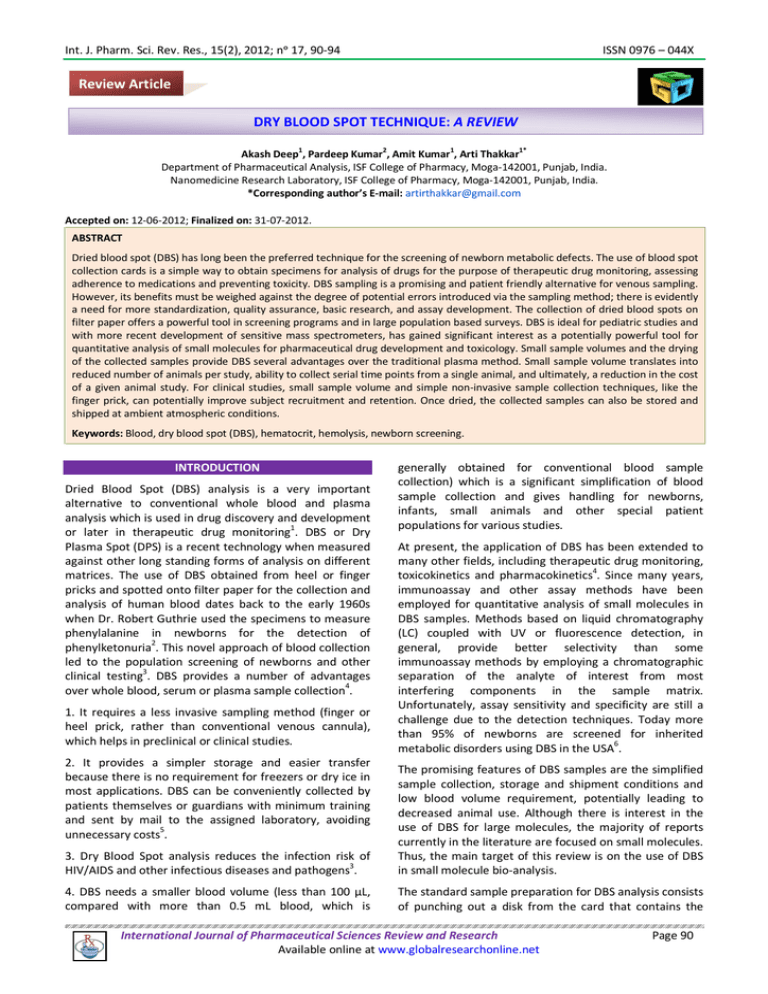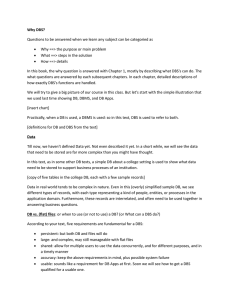Document 13308845
advertisement

Int. J. Pharm. Sci. Rev. Res., 15(2), 2012; nᵒ 17, 90-94 ISSN 0976 – 044X Review Article DRY BLOOD SPOT TECHNIQUE: A REVIEW 1 2 1 1* Akash Deep , Pardeep Kumar , Amit Kumar , Arti Thakkar Department of Pharmaceutical Analysis, ISF College of Pharmacy, Moga-142001, Punjab, India. Nanomedicine Research Laboratory, ISF College of Pharmacy, Moga-142001, Punjab, India. *Corresponding author’s E-mail: artirthakkar@gmail.com Accepted on: 12-06-2012; Finalized on: 31-07-2012. ABSTRACT Dried blood spot (DBS) has long been the preferred technique for the screening of newborn metabolic defects. The use of blood spot collection cards is a simple way to obtain specimens for analysis of drugs for the purpose of therapeutic drug monitoring, assessing adherence to medications and preventing toxicity. DBS sampling is a promising and patient friendly alternative for venous sampling. However, its benefits must be weighed against the degree of potential errors introduced via the sampling method; there is evidently a need for more standardization, quality assurance, basic research, and assay development. The collection of dried blood spots on filter paper offers a powerful tool in screening programs and in large population based surveys. DBS is ideal for pediatric studies and with more recent development of sensitive mass spectrometers, has gained significant interest as a potentially powerful tool for quantitative analysis of small molecules for pharmaceutical drug development and toxicology. Small sample volumes and the drying of the collected samples provide DBS several advantages over the traditional plasma method. Small sample volume translates into reduced number of animals per study, ability to collect serial time points from a single animal, and ultimately, a reduction in the cost of a given animal study. For clinical studies, small sample volume and simple non-invasive sample collection techniques, like the finger prick, can potentially improve subject recruitment and retention. Once dried, the collected samples can also be stored and shipped at ambient atmospheric conditions. Keywords: Blood, dry blood spot (DBS), hematocrit, hemolysis, newborn screening. INTRODUCTION Dried Blood Spot (DBS) analysis is a very important alternative to conventional whole blood and plasma analysis which is used in drug discovery and development or later in therapeutic drug monitoring1. DBS or Dry Plasma Spot (DPS) is a recent technology when measured against other long standing forms of analysis on different matrices. The use of DBS obtained from heel or finger pricks and spotted onto filter paper for the collection and analysis of human blood dates back to the early 1960s when Dr. Robert Guthrie used the specimens to measure phenylalanine in newborns for the detection of 2 phenylketonuria . This novel approach of blood collection led to the population screening of newborns and other clinical testing3. DBS provides a number of advantages over whole blood, serum or plasma sample collection4. 1. It requires a less invasive sampling method (finger or heel prick, rather than conventional venous cannula), which helps in preclinical or clinical studies. 2. It provides a simpler storage and easier transfer because there is no requirement for freezers or dry ice in most applications. DBS can be conveniently collected by patients themselves or guardians with minimum training and sent by mail to the assigned laboratory, avoiding unnecessary costs5. generally obtained for conventional blood sample collection) which is a significant simplification of blood sample collection and gives handling for newborns, infants, small animals and other special patient populations for various studies. At present, the application of DBS has been extended to many other fields, including therapeutic drug monitoring, toxicokinetics and pharmacokinetics4. Since many years, immunoassay and other assay methods have been employed for quantitative analysis of small molecules in DBS samples. Methods based on liquid chromatography (LC) coupled with UV or fluorescence detection, in general, provide better selectivity than some immunoassay methods by employing a chromatographic separation of the analyte of interest from most interfering components in the sample matrix. Unfortunately, assay sensitivity and specificity are still a challenge due to the detection techniques. Today more than 95% of newborns are screened for inherited metabolic disorders using DBS in the USA6. 3. Dry Blood Spot analysis reduces the infection risk of 3 HIV/AIDS and other infectious diseases and pathogens . The promising features of DBS samples are the simplified sample collection, storage and shipment conditions and low blood volume requirement, potentially leading to decreased animal use. Although there is interest in the use of DBS for large molecules, the majority of reports currently in the literature are focused on small molecules. Thus, the main target of this review is on the use of DBS in small molecule bio-analysis. 4. DBS needs a smaller blood volume (less than 100 µL, compared with more than 0.5 mL blood, which is The standard sample preparation for DBS analysis consists of punching out a disk from the card that contains the International Journal of Pharmaceutical Sciences Review and Research Available online at www.globalresearchonline.net Page 90 Int. J. Pharm. Sci. Rev. Res., 15(2), 2012; nᵒ 17, 90-94 DBS followed by extraction of the analyte. The punched sample disks typically range in diameter from 3-8 mm and are extracted with an organic solvent, or a mixture of aqueous and organic solvent. Internal standard (IS) is also used then added to the extraction solvent. LC–MS/MS is used for analysis the extract. This latest approach is suitable for the wide majority of compounds. However, if this process is to be performed manually, this will be time consuming and labor intensive. There is an emerging need for greater efficiency, either through automation of the sample preparation process or alternative approaches that require minimal or no sample preparation, such as direct analysis of DBS. DRIED BLOOD SPOT SAMPLE COLLECTION, PROCESSING, STORAGE AND TRANSPORTATION For collection of DBS samples is normally conducted by pricking the finger, heel or toe with a lancet, and the blood drops are then spotted onto preprinted circles on DBS. Before exploring the use of DBS sampling, a detailed check on the physicochemical properties of the target analyte is necessary. Remember that volatile and/or airsensitive analytes should not be collected on DBS card/paper. The full details of blood sample collection, collecting device, transfer of blood onto the DBS card/paper and storage and transportation of DBS samples have been well described in the National Committee for Clinical Laboratory Standards document7. Blood Sample Collection Blood samples are to be collected in the household from eligible women and children by finger or heel prick. The puncture site is to be cleaned with alcohol, air dried, and puncture with a sterile retractable lancet. Blood drops were allowed to fall freely inside preprinted circles on special filter paper cards. The filter paper cards were placed in drying boxes containing desiccants to protect the samples from moisture. In preclinical studies, small animals such as mouse, rat etc. can be tail bled. Clotting, layering or supersaturating should be prevented. The predefined circle must be homogenously and symmetrically filled and both sides of the card/paper must show the same red color. Samples indicating contamination or hemolysis or with insufficient volume collected are deemed to unsuitable8. The blood sample can also be applied with a calibrated pipette onto the sampling paper/card, thus avoiding potential variability in blood samples due to hematocrit effect, blood volume influence, possible uneven distribution of blood on the card/paper and other sampling errors. The pipette tip should be a few millimeters above the card/paper. As the blood drop touches the card/paper, it should be swiftly 9 expelled . Processing, Storage and Transportation In general, a minimum of 2-3 hours for drying of blood spots in an open space at room temperature (15-22°C) is ISSN 0976 – 044X recommended. It is very important to dry blood spots completely before storage or transportation. Generally, the drying time depends on the type of paper/card and 10 the blood volume which is applied on DBS card . The major precaution is that samples should not be heated, stacked or allowed to touch other surfaces, and should be kept away from direct sunlight or daylight. Moisture might affect the quality of the blood samples on the card/paper by inducing bacterial growth, altering extraction efficiency during analysis or facilitating degradation of unstable analytes. Then, after drying, the DBS samples should be protected against humidity and moisture. So covering them with a paper overlay and packing them in low gas-permeable zip-closure bags with desiccant packages. Humidity indicator cards should be included in the storage package. DBS samples protected in this manner may be stored at room temperature for 11 many weeks, months or years . However, samples that contain unstable compounds should be stored at a lower temperature likewise 2-8°C, ≤ − 15°C or ≤ − 60°C; for enhancing stability and to be packed in a high-quality bond envelope. DBS Paper/card Schleicher & Scheull 903 (S&S 903, Whatman 903 or 903®) paper, manufactured from 100% pure cotton linters with no wet strength and added additives, is an FDA listed class II medical device. Some other cards/papers, such as No. 545 filter paper (Advantec, Toyo, Tokyo) have also been used. The DBS paper/card might be further treated via impregnation for an improved extraction recovery12,13. EFFECT OF BLOOD PROPERTIES ON THE USE OF DBS SAMPLING Hematocrit (HT), packed cell volume or erythrocyte volume fraction is the proportion of blood volume that is occupied by red blood cells. Independent of body size, HT is considered an integral part of a subject’s complete blood count results, along with hemoglobin concentration, white blood cells count and platelets count. HT is normally about 0.41-0.51 for men and 0.370.47 for women. The percentage might be out of the above ranges in certain populations, like 0.28-0.67 for neonates (0-1 year old) and 0.35-0.42 for children (2-12 years old). Capillary blood tends to have a higher HT (0.61) than venous blood 14. Since HT is directly proportional to the viscosity of blood, it affects diffusion properties of the blood spotted on the paper/card. At a high HT value, the distribution of blood sample through the paper/card might be poor, resulting in a smaller blood spot when compared with the blood sample with a low HT. This means that more blood sample per punch would be taken for analysis, leading to a higher measured analyte concentration than that from the low HT. DBS samples (tested the effect of five increasing HT values (0.2, 0.3, 0.4, 0.5 & 0.6) in combination with two different positions of the punch for 31 amino acids and acylcarnitines. For all test analytes that showed a correlation with the HT, concentrations were found to be International Journal of Pharmaceutical Sciences Review and Research Available online at www.globalresearchonline.net Page 91 Int. J. Pharm. Sci. Rev. Res., 15(2), 2012; nᵒ 17, 90-94 significantly higher in samples with high HT and significantly lower in those with low HT regardless of the position of the punch. However, it seems that HT effect is 15 case-dependent . APPLICATIONS Newborn Screening There are many situations in newborn screening where absolute concentration of a single biomarker molecule may not be diagnostic; instead, accurate quantification of multiple biomarker molecules using LC-MS/MS, followed by comparison of response ratios of one species to the other(s), is more powerful16. Many recent applications in the newborn screening using LC-MS/MS have demonstrated that the technique is a better choice than MS alone or some other means for the accurate quantification of biomarker molecules in the DBS samples17. Among these applications, the screening for congenital adrenal hyperplasia (CAH) might be a good example. 17Hydroxyprogesterone (17-OHP) is one of the biomarker molecules for the early diagnosis of CAH. The development of an immunoassay; to determine the 17OHP concentration in blood spots in newborns screening, was introduced in 197718. Unfortunately, due to a physiologically delayed expression of the enzyme 11βhydroxylase in premature babies; illness, birth stress, impaired kidney function, interference from 17-OHP metabolite(s) and cross-reactivity of antibodies with other steroids particularly 17-hydroxypregnenolone (17OHPreg), the positive predictive rate for CAH population screening using immunoassay remains below 1%, despite attempts to adjust cut-off levels for birth weight, gestational age and stress factors. 17-OHP has a molecular weight of 330 Dalton (Da), 2 Da less than that of the interfering compound 17-OHPreg (332 Da). Both compounds could be distinguished by mass spectrometry via any detection mode (Q1scan, product scan, or selected reaction monitoring)19. ISSN 0976 – 044X Preclinical Study Although very few applications of DBS in preclinical study have been published on toxicokinetic or pharmacokinetic assessment of drug or drug candidates in small animals. The potential benefits of using this technique are too pronounced to be ignored by pharmaceutical industry. The small blood volume (<100 µL for multiple spots) used for DBS sampling makes its use possible for serial bleeding from small animals20, 21. In all cases where serum or plasma, instead of DBS, has been used as the matrix for quantitative analysis of drugs during discovery and development, it would be necessary to determine the relationship between the analyte concentration in the two matrices (plasma/serum V/s DBS). HT is an important parameter that needs to be considered. Without correcting for its impact, the analytical results from DBS would be much lower than those obtained via plasma or serum, regardless of which assay might have been used for the analysis of plasma or serum samples10. Therapeutic Drug Monitoring DBS LC-MS/MS has been increasingly employed in clinical study and therapeutic drug monitoring for the analysis of a wide spectrum of drug molecules including antipyretics, antitussives, antimalarials, anticonvulsants, antiretrovirals, immunosuppressants, antiepileptics & Vinca alkaloids and in monitoring drug abuse. Because DBS samples could be collected by patients themselves or their guardians with minimum training, this opens up the possibilities of collecting clinical pharmacokinetic samples not only from various in-patients but also from outpatients, especially those from remote areas. This is meaningful when there is a need to monitor drugs, for instance tacrolimus and cyclosporine A, with a narrow therapeutic index, but a wide inter-patient and intrapatient pharmacokinetic variation, DBS samples can be promptly taken whenever a concentration related Side effect appears. The obtained analytical results might lead to a necessary adjustment of dose or dose regimen 22-24. Figure 1: Schematic of Dried Blood Spot Analysis (Source: Minnesota Department of Health) International Journal of Pharmaceutical Sciences Review and Research Available online at www.globalresearchonline.net Page 92 Int. J. Pharm. Sci. Rev. Res., 15(2), 2012; nᵒ 17, 90-94 Dried Blood Spot Analysis in Toxicology There is some limited and early research onto using this method as a screening test for HIV. Now, some in the forensic arena have watched the research advancements in this technology and are investigating its possible application to the forensic science world. Some are seeking to prove its validity in terms of a confirmation test in analysis of abusive drugs. What also spurs on this research are the strides being made in the clinical and pharmaceutical field. There is a large push to move in this direction in the clinical era due to cost savings as well as the analyst and collector being exposed to less bio-hazards. There were a lot of presentations on it that I have noticed in the last several national clinical meetings. In the pharmaceutical industry, there is also a push to get the FDA to more readily accept it in animal studies as it will reduce the numbers of animals needed for a given study. Thus, it will save a lot of money. The whole idea is reduce the amount of blood volume necessary and save money20, 25. In the peer reviewed research that has been published concerning DBS, there is some limited data in terms of the correlation to whole blood of plasma blood, and in terms of recovery using this method for qualitative and quantitative analysis. It confirms that this is an emerging field and there are still a lot of questions as to its validity especially as to its possible quantitative use. CONCLUSION Although DBS may be the primary method of blood sample collection in newborn screening and its use as a convenient blood sampling method in therapeutic drug monitoring has been expanding, it is not expected to replace the conventional whole blood, plasma or serum collection in all preclinical and clinical studies. The use of DBS bears some apparent disadvantages too because the collected blood volume is very small, assay sensitivity is always a challenge for the determination of some analytes at low circulating levels. Repeat analyses and/or additional analysis for drug metabolites or other molecules can be very difficult. Unfortunately, the metabolite concentration is usually very low compared with the parent compounds. Unlike aqueous matrix such as whole blood, plasma or serum, for which sample homogeneity could be easily ensured during sample collection and prior to analysis, the quality of DBS samples is often a concern for absolute quantification due to the possible DBS card/paper quality issue, possible non-compliance in sample collection (blood volume on the spot, degree of saturation and degree of hemolysis, drying, storage and transportation, and a wide variety of blood properties of the intended population. Any of the above uncertainties might lead to a higher degree of assay errors using this nonvolumetrically (size) based approach for quantitative analysis than the conventional methods. Manual punching is very time-consuming and is definitely not ISSN 0976 – 044X suited for the current high-throughput environment. A punch device could be a source of assay error and/or contamination. More importantly, whereas most analytes may be stable on DBS after drying, some enzyme labile compounds, especially prodrugs, are unstable even with the pretreated card/paper. This could present another challenge for DBS sampling method as enzyme inhibitors cannot be conveniently mixed during sample collection. REFERENCES 1. Konig S, Yildiz O, Hermann N, Steurer A, Singrasa M, Dobelin W. A Novel Concept for Sample Collection and Sample Preparation. Poster WP 427. Salt Lake City: ASMS 2010. 2. Guthrie R, Susi A. A Simple Phenylalanine Method for Detecting Phenylketonuria in Large Populations of Newborn Infants. Pediatrics 32; 1963, 338-43. 3. Parker SP, Cubitt WD. The use of the dried blood spot sample in epidemiological studies. J Clin Pathol 52; 1999, 633-9. 4. Edelbroek PM, van der Heijden J, Stolk LM. Dried blood spot methods in therapeutic drug monitoring: methods, assays, and pitfalls. Ther Drug Monit 31; 2009, 327-36. 5. Garcia Boy R, Henseler J, Mattern R, Skopp G. Determination of morphine and 6-acetylmorphine in blood with use of dried blood spots. Ther Drug Monit 30; 2008, 733-9. 6. Chace DH, Kalas TA, Naylor EW. Use of tandem mass spectrometry for multianalyte screening of dried blood specimens from newborns. Clin Chem 49; 2003, 1797-817. 7. Garg U, Dasouki M. Expanded newborn screening of inherited metabolic disorders by tandem mass spectrometry: clinical and laboratory aspects. Clin Biochem 39; 2006, 315-32. 8. Beaudette P, Bateman KP. Discovery stage pharmacokinetics using dried blood spots. J Chromatogr B Analyt Technol Biomed Life Sci 809; 2004, 153-8. 9. Alfazil AA, Anderson RA. Stability of benzodiazepines and cocaine in blood spots stored on filter paper. J Anal Toxicol 32; 2008, 511-5. 10. Koal T, Burhenne H, Romling R, Svoboda M, Resch K, Kaever V. Quantification of antiretroviral drugs in dried blood spot samples by means of liquid chromatography/tandem mass spectrometry. Rapid Commun Mass Spectrom 19; 2005, 2995-3001. 11. Burhenne J, Riedel KD, Rengelshausen J, Meissner P, Muller O, Mikus G et al. Quantification of cationic anti-malaria agent methylene blue in different human biological matrices using cation exchange chromatography coupled to tandem mass spectrometry. J Chromatogr B Analyt Technol Biomed Life Sci 863; 2008, 273-82. 12. Higashi T, Nishio T, Uchida S, Shimada K, Fukushi M, Maeda M. Simultaneous determination of 17alphahydroxypregnenolone and 17alpha-hydroxyprogesterone in dried blood spots from low birth weight infants using LCMS/MS. J Pharm Biomed Anal 48; 2008, 177-82. International Journal of Pharmaceutical Sciences Review and Research Available online at www.globalresearchonline.net Page 93 Int. J. Pharm. Sci. Rev. Res., 15(2), 2012; nᵒ 17, 90-94 13. Mei JV, Alexander JR, Adam BW, Hannon WH. Use of filter paper for the collection and analysis of human whole blood specimens. J Nutr 131; 2001, 1631S-6S. 14. Kayiran SM, Ozbek N, Turan M, Gurakan B. Significant differences between capillary and venous complete blood counts in the neonatal period. Clin Lab Haematol 25; 2003, 9-16. 15. Adam BW, Alexander JR, Smith SJ, Chace DH, Loeber JG, Elvers LH et al. Recoveries of phenylalanine from two sets of dried-blood-spot reference materials: prediction from hematocrit, spot volume, and paper matrix. Clin Chem 46; 2000, 126-8. 16. Carpenter KH, Wiley V. Application of tandem mass spectrometry to biochemical genetics and newborn screening. Clin Chim Acta 322; 2002, 1-10. 17. la Marca G, Malvagia S, Casetta B, Pasquini E, Donati MA, Zammarchi E. Progress in expanded newborn screening for metabolic conditions by LC-MS/MS in Tuscany: update on methods to reduce false tests. J Inherit Metab Dis 31 Suppl 2; 2008, S395-404. 18. Pang S, Hotchkiss J, Drash AL, Levine LS, New MI. Microfilter paper method for 17 alphahydroxyprogesterone radioimmunoassay: its application for rapid screening for congenital adrenal hyperplasia. J Clin Endocrinol Metab 45; 1977, 1003-8. 19. Wong T, Shackleton CH, Covey TR, Ellis G. Identification of the steroids in neonatal plasma that interfere with 17 alpha-hydroxyprogesterone radioimmunoassays. Clin Chem 38; 1992, 1830-7. ISSN 0976 – 044X 20. Barfield M, Spooner N, Lad R, Parry S, Fowles S. Application of dried blood spots combined with HPLC-MS/MS for the quantification of acetaminophen in toxicokinetic studies. J Chromatogr B Analyt Technol Biomed Life Sci 870; 2008, 32-7. 21. Spooner N, Lad R, Barfield M. Dried blood spots as a sample collection technique for the determination of pharmacokinetics in clinical studies: considerations for the validation of a quantitative bioanalytical method. Anal Chem 81; 2009, 1557-63. 22. Cheung CY, van der Heijden J, Hoogtanders K, Christiaans M, Liu YL, Chan YH et al. Dried blood spot measurement: application in tacrolimus monitoring using limited sampling strategy and abbreviated AUC estimation. Transpl Int 21; 2008, 140-5. 23. Hoogtanders K, van der Heijden J, Christiaans M, Edelbroek P, van Hooff JP, Stolk LM. Therapeutic drug monitoring of tacrolimus with the dried blood spot method. J Pharm Biomed Anal 44; 2007, 658-64. 24. Liang X, Li Y, Barfield M, Ji QC. Study of dried blood spots technique for the determination of dextromethorphan and its metabolite dextrorphan in human whole blood by LCMS/MS. J Chromatogr B Analyt Technol Biomed Life Sci 877; 2009, 799-806. 25. McShane JJ. Emerging Science: Dried Blood Spot Analysis in Toxicology. The Truth About Forensic Science 2011 [cited 2011 28 May, 2011]; Available from: http://www.thetruthaboutforensicscience.com/emergingscience-dried-blood-spot-analysis-in-toxicology/. ********************** International Journal of Pharmaceutical Sciences Review and Research Available online at www.globalresearchonline.net Page 94


